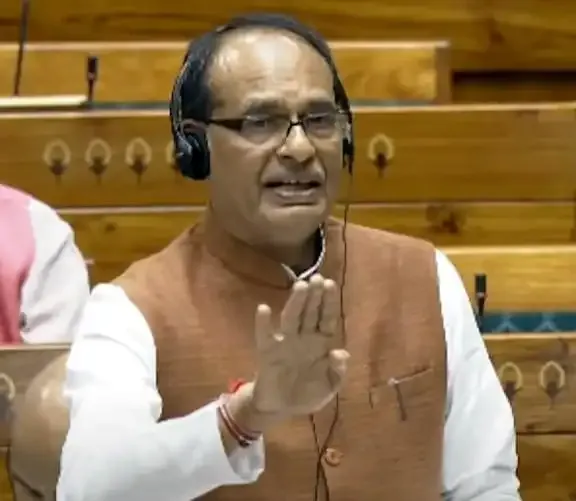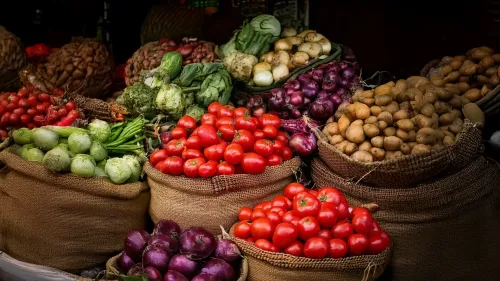Has the Centre Really Doubled MSP for Crops and Increased Procurement?

Synopsis
Key Takeaways
- MSP for crops has doubled.
- Procurement levels have surged under Modi government.
- PM-AASHA scheme supports farmers against exploitation.
- Institutional credit for agriculture has significantly increased.
- Robust measures are in place to protect farmers’ interests.
New Delhi, July 29 (NationPress) The minimum support prices (MSP) provided by the Centre to farmers for various crops have indeed doubled, and procurement levels have surged under the leadership of Prime Minister Narendra Modi, as stated by Union Minister for Agriculture & Farmers Welfare Shivraj Singh Chouhan during a session in Parliament on Tuesday.
Chouhan noted, "In the previous administration, merely 6 lakh metric tonnes of pulses were procured over a span of 10 years. However, under the current administration, this number has dramatically risen to 1.82 crore metric tonnes.”
He further informed the House about the introduction of the PM-AASHA scheme aimed at procuring pulses and oilseeds, such as tur, masoor, and urad, at a 100% MSP. Measures have been implemented to prevent middlemen from taking advantage of farmers, ensuring that MSP rates are effectively delivered.
Chouhan provided compelling data indicating that MSP rates have seen substantial increases: for paddy, the procurement price has escalated from Rs 1,310 (2013–14) to Rs 2,369; for bajra, from Rs 1,250 to Rs 2,775; for ragi, from Rs 1,500 to Rs 4,886; for maize, from Rs 1,310 to Rs 2,400; for tur, from Rs 4,300 to Rs 8,000; for moong, from Rs 4,500 to Rs 8,768; for urad, from Rs 4,300 to Rs 7,800; and for groundnut, from Rs 4,000 to Rs 7,263.
For sunflower, the price rose from Rs 3,700 to Rs 7,721; for soybean, from Rs 2,560 to Rs 5,328; for sesame, from Rs 4,500 to Rs 9,846; for niger seed, from Rs 3,500 to Rs 9,537; and for cotton, from Rs 3,700 to Rs 7,710, he added.
To enhance farmers' income, the government has committed to ensuring a minimum profit margin of 50% over costs in MSP. Extensive procurement efforts are ongoing, and farmers are receiving compensation for crop losses. Additionally, subsidized fertilizers like urea and DAP (Diammonium Phosphate) are being made readily available.
Chouhan highlighted key initiatives aimed at agricultural development, including boosting production, lowering input costs to increase farmers' income, and ensuring fair pricing for agricultural products.
Over the last decade, India's agricultural crop production has risen from 246.42 million tonnes to 353.96 million tonnes. The output of pulses increased from 16.38 million tonnes to 25.24 million tonnes, while oilseed production surged from 27.51 million tonnes to 42.61 million tonnes. Horticultural production also witnessed a significant jump from 280.70 million tonnes to 367.72 million tonnes. Furthermore, there has been a remarkable rise in milk production, entirely fueled by farmers.
Chouhan stated that the current budget allocation for agriculture under the National Democratic Alliance (NDA) government is Rs 1.27 lakh crore, a massive increase compared to the previous UPA government's allocation of a mere Rs 27,000 crore.
He also noted an increase in institutional credit from Rs 7 lakh crore during the UPA period to Rs 25 lakh crore today. Regarding the Pradhan Mantri Fasal Bima Yojana (PMFBY), he mentioned that the Centre has released claims worth Rs 1.83 lakh crore against a premium collection of Rs 35,000 crore directly into farmers’ accounts.
Furthermore, Chouhan explained that the PMFBY has been revamped to be more beneficial for farmers. If an insurance company fails to process a claim within 21 days of the deadline, 12% interest will be charged and credited directly to the farmer's account. The same interest rate applies if a state government delays its portion of the premium.









